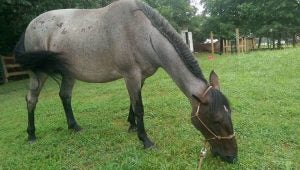Before the rush of winter really arrives, often the last thing on landowners’ minds is pastures covered in snow. But experts say now is indeed the time to think about winter pasture management.
Debra Powell, Ph.D., associate professor of equine studies at Saint Mary-of-the-Woods College, said for pastures in most of the Midwest, a little work in late summer and early fall will go a long way by spring.
“Ideally, in the perfect world, we should be resting the pastures in winter,” she said, numbering off several to-do’s in advance of this goal. The number of horses you can graze per acre will depend on a number of factors, including weather and location, but as a rule, winter is a time of rest of the pasture.
Likewise, the University of Minnesota Extension Office notes that, on average, a pasture needs 30 days of rest after one to two weeks, but the length really depends on: Time of year, number of horses, acreage, quantity and quality of forage, and soil health.
Saint Mary-of-the-Woods College is located outside Terre Haute, Indiana, near the Illinois border a few miles north of Interstate 70. One of only about 20 equestrian colleges in the United States, the Catholic liberal arts school has bachelor’s degrees in equine business management, equine studies, equine training and instruction, as well as a minor in equine science. In addition to a rural campus, which features sustainable farming and eco-justice programs, the school has a fully equipped horse program and partners with the Sisters of Providence in maintaining other agriculture operations.

Maintaining the pastures for the school’s horses is part and parcel to the operation. Here are five key pieces of advice from the school:
1. Pull off horses and get a soil sample
Powell said with horses, late August is a good time to start preparing for the resting period. With the horses off the grounds, take a moment to look and around ask a few questions. Can we increase efficiency here by adding laneways? Can we consider rotational grazing? Are multiple grazing systems an option? While those thoughts bubble about, have a soil sample done. If you haven’t had the soil tested within the last three years, you can take one anytime the ground isn’t frozen with a kit from your local extension office. The soil test report will give you plenty of information to use in determining how to proceed with the other questions, as well as the next steps.
2. Fertilize per the soil test guidance
Based on the results of the soil test, varying mixes of nitrogen, phosphorus, potassium, and lime might be needed, or the compost might suffice. Some equine owners prefer a more natural approach to fertilization, and organic options are available. Be sure not to over- or under-fertilize. The soil test report will give recommendations for these mixes, and you should consult a local extension agent on timing of application as this could vary by regional factors. This report information will also play into the questions of efficiency and potential changes as nutrient levels could be impacted by the number of horses per acre and types of grasses. Fall is a good time to spread compost, based on nutrient recommendations, as one wants to avoid spreading this on frozen or snow-covered ground.
3. To seed or re-seed?
Powell said fall is a good time to determine whether or not to re-seed. Again, this is a decision one should make in conjunct with a soil test and advice from local experts. Spreading seed in mid-August to September works well for a spring rise in the Midwest, where Timothy, Orchard Grass, and Kentucky Bluegrass are utilized frequently.
4. Check fencing
The good thing about checking fencing in the fall is that weed pressure has slowed and temperatures are cooling. Thistles and other invasive plants will stick out in plain sight better, and if fences need to be cleaned, now is the time to do it while the horses are off. This is also a good time to review operational efficiency and determine whether different paddock arrangements might be in order.
5. Test water heaters, hay supply, and other barn equipment
Be prepared, as the old saying goes. Tools like the National Weather Service Climate Prediction Center can certainly help give livestock owners advance notice of potential temperature issues, but waiting until the next Polar Vortex hits to check frozen water lines and short hay supplies is no way to go. Also, be sure to make sure the hay storage area is free from leaks or rodent holes.
A little work in the months of late summer and early fall can help answer questions necessary to bring about a spring full of lush green pasture for horses to enjoy throughout the year. Good pasture management is a key ingredient to any successful equine operation.



